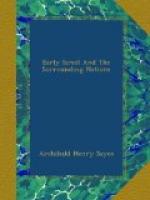Two years, however, were hardly past when it revolted, and while on the march to subdue it Esar-haddon fell ill, and died on the 10th of Marchesvan or October. But the revolt was quickly suppressed by his successor Assur-bani-pal, and the twenty satrapies restored. It was not long, however, before the satraps quarrelled with one another, intrigued with Taharka, and rebelled against their suzerain. Headed by Necho of Sais, they invited the Ethiopians to return; but the plot was discovered, and Necho and his fellow-conspirators sent in chains to Nineveh. Sais, Mendes, and other cities of northern Egypt were sacked, and Taharka, who had advanced as far as Thebes and even Memphis, fled to Ethiopia and there died. Meanwhile Necho had been pardoned and loaded with honours by the Assyrian king; his son, who took an Assyrian name, was made satrap of Athribis, near the modern Benha, and the satraps of the Delta henceforward remained faithful to their Assyrian master. But another Ethiopian prince, Tuant-Amon, made a last attempt to recover the dominion of his fathers. Thebes received him with acclamation, and Memphis was taken without difficulty. There the satrap of Goshen came to pay him homage on behalf of his brother-governors in the north.
His triumph, however, was short-lived. Assur-bani-pal determined to inflict a terrible punishment on the rebel country, and to reduce it to subjection once for all. Thebes had been the centre of disaffection; its priesthood looked with impatience on the rule of the Asiatic, and were connected by religion and tradition with Ethiopia; on Thebes and its priesthood, therefore, the punishment had to fall. The Ethiopian army retreated to Nubia without striking a blow, and Egypt was left defenceless at the mercy of the Assyrian. The Assyrian army entered Thebes, the No or “City” of Amon, bent on the work of destruction. Its temple-strongholds were plundered and overthrown, its inhabitants carried into slavery, and two obelisks, seventy tons in weight, were sent as trophies to Nineveh. The sack of Thebes made a deep impression on the Oriental world; we find it referred to in the prophecies of Nahum (iii. 8).
Egypt now enjoyed peace, but it was the peace of exhaustion and powerlessness. Psammetikhos had succeeded his father Necho, who had been put to death by Tuant-Amon. He was a man of vigour and ability, and he aimed at nothing less than sovereignty over an united and independent Egypt. His opportunity came in B.C. 655. The Assyrian empire was shaken to its foundations by a revolt of which Babylonia was the centre and which had spread to its other provinces. For a time it was called on to struggle for bare existence. While the Assyrian armies were employed elsewhere, Psammetikhos shook himself free of its authority, and, with the help of Greek and Karian mercenaries from Lydia, overcame his rival satraps and mounted the throne of the Pharaohs. Once more, under the Twenty-sixth dynasty, Egypt enjoyed rest and prosperity; the administration was re-organised, the cities and temples restored, and art underwent an antiquarian revival. Psammetikhos even dreamed of recovering the old supremacy of Egypt in Asia; the Assyrian empire was falling into decay, and Egypt was endeavouring to model its life after the pattern of the past. After a long siege Ashdod was taken, and the control of the road into Palestine was thus secured.




